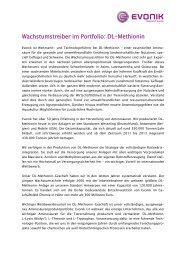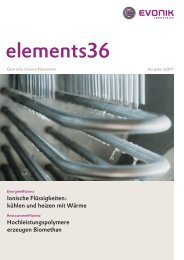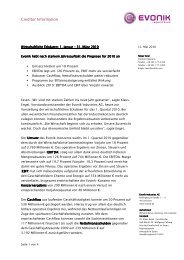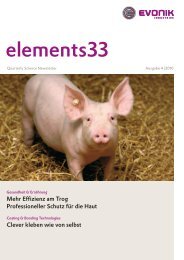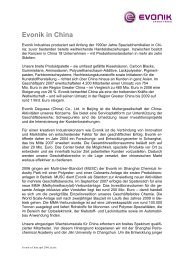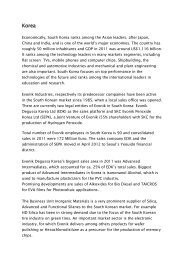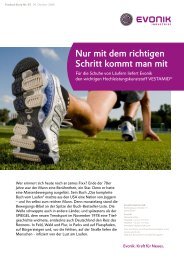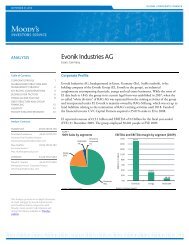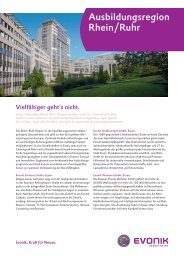Sodium cyanide - Evonik Industries
Sodium cyanide - Evonik Industries
Sodium cyanide - Evonik Industries
You also want an ePaper? Increase the reach of your titles
YUMPU automatically turns print PDFs into web optimized ePapers that Google loves.
Uses and application<br />
<strong>Sodium</strong> <strong>cyanide</strong> is used primarily as starting material in the manufacture of<br />
other chemicals. The substance is used for extraction and recycling of<br />
precious metals, as a processing aid in electroplating and as a surface<br />
treatment agent in metal hardening.<br />
Physical/chemical properties<br />
<strong>Sodium</strong> <strong>cyanide</strong> is a white crystalline solid with a faint bitter-almond like<br />
odour. The solid has a density higher than water. The melting point of this<br />
substance is 562 °C and the boiling point 1500 °C. Alkali <strong>cyanide</strong> salts are<br />
soluble in water liberating HCN unless pH is strongly alkaline.<br />
Property Value<br />
Density 1.595 g/cm3 (20°C)<br />
Melting / Boiling point 562°C / 1500°C<br />
Molecular weight 49.0072 g/mol<br />
Health effects<br />
Based on available data, <strong>Sodium</strong> <strong>cyanide</strong> is fatal if swallowed, inhaled and<br />
absorbed through the skin. Standard tests indicate the substance is not<br />
mutagenic or genotoxic. Data shows no evidence of reproductive toxicity or<br />
carcinogenicity.<br />
Effect Assessment Result<br />
Acute toxicity (oral, dermal Fatal if swallowed, inhaled and<br />
and inhalation)<br />
absorbed through the skin.<br />
Eye / Skin irritation Due to the acute toxicity the irritative<br />
effect on the eye and skin cannot be<br />
determined.<br />
Sensitization Due to the acute toxicity the sensitizing<br />
potential cannot be determined.<br />
Toxicity after repeated<br />
Acutely toxic effects are predominant<br />
exposure<br />
via oral, dermal and inhalative route.<br />
Repeated exposure is correlated with<br />
thyroid enlargement.<br />
Genotoxicity / mutagenicity Not mutagenic / not genotoxic<br />
Carcinogenicity No evidence that the material is<br />
carcinogenic based on available data.<br />
Toxicity for reproduction No evidence that the material is a<br />
reproductive toxin based on available<br />
data.<br />
<strong>Evonik</strong> <strong>Industries</strong> GmbH | GPS Safety Summary| December 2012 | Version 2 |page 2/6



